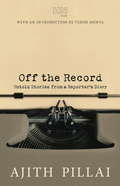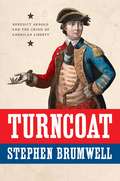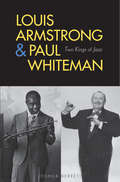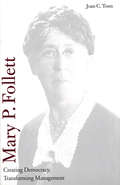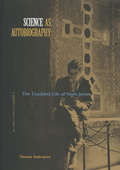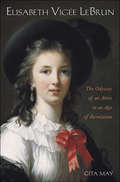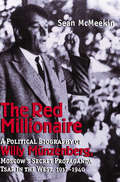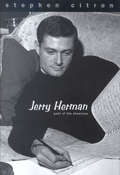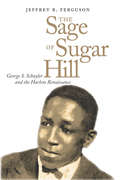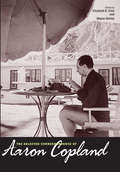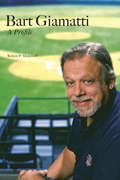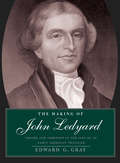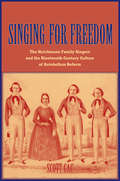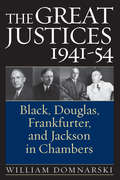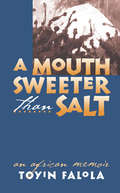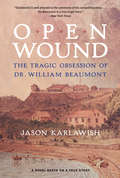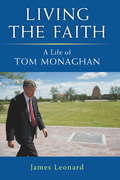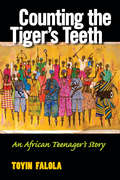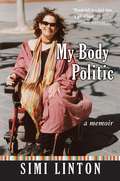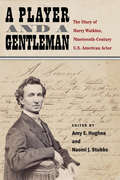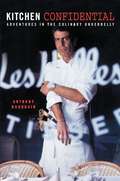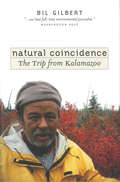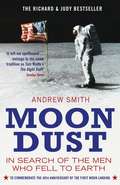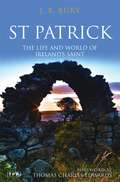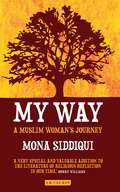- Table View
- List View
Off the Record: Untold Stories from a Reporter's Diary
by Ajith Pillai‘[Ajith’s book] is the first full account I have seen between hard covers which is exclusively about a journalist’s adventures and journeys in the field... An extraordinary first “rough draft of history”, a portrait of India from the 80s to the present time.’ – Vinod Mehta ‘Ajith Pillai’s account of his journalistic odyssey covers the period of India’s Great Transformation from the 1980s to the present. He does so with incisive wit and insight into a breathtaking range of issues. This ought to be a handbook for all aspiring journalists, since Pillai is an enemy of sycophantic corporate ideology and craven submissiveness to wealth and power which characterize most of today’s celebritywriters.’ – Jeremy Seabrook, British author and columnist In a journalist’s career, the best stories can seldom be published… Veteran journalist Ajith Pillai’s colourful career spanning nearly three decades has taken him from the murky underworld of Bombay to the icy heights of Kargil; yet, the reports he has written are only half the story. Now, for the first time, the ‘off-the-record’ experiences that never found their way to print are presented in this witty and engaging memoir. Beginning with a call from a furious Chota Shakeel, Dawood Ibrahim’s right-hand man, asking him to retract a story on ‘Bhai’ or face the consequence, Ajith takes the reader on a journey that sees him guide V.S. Naipaul to meet the ‘boys’ from the underworld; follow the sensuous Silk Smitha around Bombay on a New Year’s eve; witness the first shots of Operation Vijay during the Kargil War; track, along with a colleague, a Brigadier accused of high treason across the country; stumble upon embarrassed Congressmen in Kamathipura, Bombay’s red-light district; discover who was actually pulling the strings during Vajpayee’s tenure as PM; and coordinate the coverage of the multimillion dollar Scorpene submarine scam and the sensational Radia tapes. Written with Ajith’s trademark wry humour, these real stories, often more entertaining than fiction, are a testament to a journalist’s life, as well as a comment on the changing nature of the effervescent Indian media.'
Turncoat: Benedict Arnold and the Crisis of American Liberty
by Stephen BrumwellWhy did the once-ardent hero of the American Revolutionary cause become its most dishonored traitor? General Benedict Arnold’s failed attempt to betray the fortress of West Point to the British in 1780 stands as one of the most infamous episodes in American history. In the light of a shining record of bravery and unquestioned commitment to the Revolution, Arnold’s defection came as an appalling shock. Contemporaries believed he had been corrupted by greed; historians have theorized that he had come to resent the lack of recognition for his merits and sacrifices. In this provocative book Stephen Brumwell challenges such interpretations and draws on unexplored archives to reveal other crucial factors that illuminate Arnold’s abandonment of the revolutionary cause he once championed. This work traces Arnold’s journey from enthusiastic support of American independence to his spectacularly traitorous acts and narrow escape. Brumwell’s research leads to an unexpected conclusion: Arnold’s mystifying betrayal was driven by a staunch conviction that America’s best interests would be served by halting the bloodshed and reuniting the fractured British Empire.
Louis Armstrong and Paul Whiteman: Two Kings of Jazz
by Joshua BerrettIn Louis Armstrong and Paul Whiteman the jazz scholar Joshua Berrett offers a provocative revision of the history of early jazz by focusing on two of its most notable practitioners-Whiteman, legendary in his day, and Armstrong, a legend ever since.Paul Whiteman’s fame was unmatched throughout the twenties. Bix Beiderbecke, Bing Crosby, and Jimmy and Tommy Dorsey honed their craft on his bandstand. Celebrated as the "King of Jazz” in 1930 in a Universal Studios feature film, Whiteman’s imperium has declined considerably since. The legend of Louis Armstrong, in contrast, grows ever more lustrous: for decades it has been Armstrong, not Whiteman, who has worn the king’s crown.This dual biography explores these diverging legacies in the context of race, commerce, and the history of early jazz. Early jazz, Berrett argues, was not a story of black innovators and white usurpers. In this book, a much richer, more complicated story emerges-a story of cross-influences, sidemen, sundry movers and shakers who were all part of a collective experience that transcended the category of race. In the world of early jazz, Berrett contends, kingdoms had no borders.
Mary P. Follett: Creating Democracy, Transforming Management
by Professor Joan C. TonnMary P. Follett (1868-1933) brought new dimensions to the theory and practice of management and was one of America’s preeminent thinkers about democracy and social organization. The ideas Follett developed in the early twentieth century continue even today to challenge thinking about business and civic concerns. This book, the first biography of Follett, illuminates the life of this intriguing woman and reveals how she developed her farsighted theories about the organization of human relations.Out of twenty years of civic work in Boston’s immigrant neighborhoods, Follett developed ideas about the group basis of democracy and the foundations of social interaction that placed her among leading progressive intellectuals. Later in her career, she delivered influential lectures on business management that form the basis of our contemporary discourse about collaborative leadership, worker empowerment, self-managed teams, conflict resolution, the value of inclusivity and diversity, and corporate social responsibility.
Science as Autobiography: The Troubled Life of Niels Jern
by Thomas SoderqvistThis biography probes the unusual mind, the dramatic life, and the outstanding scientific work of Danish-born immunologist Niels Jerne (1911-1994). Jerne’s Nobel Prize-winning achievements in the field of immunology place him in the pantheon of great twentieth-century biomedical theorists, yet his life is perhaps even more interesting than his science. Science as Autobiography tells Jerne’s story, weaving together a narrative of his life experiences, emotional life, and extraordinarily creative scientific work.A legendary figure who preferred an afternoon of conversation in a Paris wine bar to work in the laboratory, Jerne was renowned for his unparalleled powers of concentration and analytical keenness as well as his dissonant personal life. The book explores Jerne the man and scientist, making the fascinating argument that his life experience and view of himself became a metaphorical resource for the construction of his theories. The book also probes the moral issues that surrounded Jerne’s choice to sacrifice his family in favor of scientific goals and the pursuit of excellence.
Elisabeth Vigée Le Brun: The Odyssey of an Artist in an Age of Revolution
by Gita MayThe foremost woman artist of her age, Elisabeth Vigée Le Brun (1755-1842) exerted her considerable charm to become the friend, and then official portraitist, of Marie Antoinette. Though profitable, this role made Vigée Le Brun a public and controversial figure, and in 1789 it precipitated her exile. In a Europe torn by strife and revolution, she nevertheless managed to thrive as an independent, self-supporting artist, doggedly setting up studios in Rome, Naples, Venice, Milan, Vienna, St. Petersburg, and London. Long overlooked or dismissed, Vigée Le Brun’s portraits now hang in the Louvre, in a room of their own, as well as in all leading art museums of the world.This gripping biography tells the story of a singularly gifted and high-spirited woman during the revolutionary era and explores the development and significance of her art. The book also recounts the public and private lives of Elisabeth Vigée Le Brun, connecting her with such personalities of her age as Catherine the Great, Napoleon, and Benjamin Franklin, and setting her experiences in the context of contemporary European politics and culture. A generous selection of illustrations, including sixteen of Vigée Le Brun’s portraits presented in full color, completes this exceptional volume.
The Red Millionaire: A Political Biography of Willy Münzenberg, Moscow?s Secret Propaganda Tsar in the West
by Sean McMeekinWilly Münzenberg-an Old Bolshevik who was also a self-promoting tycoon-became one of the most influential Communist operatives in Europe between the World Wars. He created a variety of front groups that recruited well-known political and cultural figures to work on behalf of the Soviet Union and its causes, and he ran an international media empire that churned out enormous amounts of propaganda and raised money for Communist concerns. Sean McMeekin tells Münzenberg’s extraordinary story, arguing persuasively that his financial chicanery and cynical propaganda efforts weakened the non-Communist left, enraged the right, and helped feed a cycle that culminated in Nazism.Drawing extensively on recently opened Moscow archives, McMeekin describes how Münzenberg parlayed his friendship with Lenin into a personal fortune and how Münzenberg’s mysterious financial manipulations outraged Social Democrats and lent rhetorical ammunition to the Nazis. His book sheds new light on Comintern finances, propaganda strategy, the use of front organizations to infiltrate non-Communist circles, and the breakdown of democracy in the Weimar Republic. It is also an engrossing tale of a Communist con man whose name once aroused fear, loathing, and admiration around the world.
Jerry Herman: Poet of the Showtune
by Mr. Stephen CitronThis revealing and comprehensive book tells the full story of Jerry Herman’s life and career, from his early work in cabaret to his recent compositions for stage, screen, and television.Stephen Citron draws on extensive open-ended interviews with Jerry Herman as well as with scores of his theatrical colleagues, collaborators, and close friends. The resulting book-which sheds new light on each of Herman’s musicals and their scores-abounds in fascinating anecdotes and behind-the-scenes details about the world of musical theater. Readers will find a sharply drawn portrait of Herman’s private life and his creative talents. Citron’s insights into Herman’s music and lyrics, including voluminous examples from each of his musicals, are as instructive as they are edifying and entertaining.
The Sage of Sugar Hill: George S. Schuyler and the Harlem Renaissance
by Jeffrey FergusonThis book is the first to focus a bright light on the life and early career of George S. Schuyler, one of the most important intellectuals of the Harlem Renaissance. A popular journalist in black America, Schuyler wielded a sharp, double-edged wit to attack the foibles of both blacks and whites throughout the 1920s. Jeffrey B. Ferguson presents a new understanding of Schuyler as public intellectual while also offering insights into the relations between race and satire during a formative period of African-American cultural history.Ferguson discusses Schuyler’s controversial career and reputation and examines the paradoxical ideas at the center of his message. The author also addresses Schuyler’s drift toward the political right in his later years and how this has affected his legacy.
The Selected Correspondence of Aaron Copland
by Aaron CoplandThis is the first book devoted to the correspondence of composer Aaron Copland, covering his life from age eight to eighty-seven. The chronologically arranged collection includes letters to many significant figures in American twentieth-century music as well as Copland’s friends, family, teachers, and colleagues. Selected for readability, interest, and the light they cast upon the composer’s thoughts and career, the letters are carefully annotated and each published in its entirety.Copland was a gifted and natural letter writer who revealed much more about himself in his letters than in formal writings in which he was conscious of his position as spokesman for modern music. The collected letters offer insights into his music, personality, and ideas, along with fascinating glimpses into the lives of such other well-known musicians as Leonard Bernstein, Carlos Chávez, William Schuman, and Virgil Thomson.
Bart Giamatti: A Profile
by Mr. Robert P. MoncreiffThis vivid portrait of Bart Giamatti encompasses his entire eventful life but focuses especially on his years at Yale University (1966-1986) and his brief career as a major league baseball executive (1986-1989). As scholar, teacher, and then university president, Giamatti was an admired and respected figure on campus. He forged his academic career during turbulent decades, and his tenure in baseball was no less contentious, for as commissioner of baseball he oversaw the banishment of Cincinnati’s Pete Rose from the game for gambling. The book draws on Giamatti’s numerous writings and speeches to illuminate the character and complexities of the man and to understand the values that motivated his leadership.Bart Giamatti was a cultural conservative and institutional moderate at a time when such values were out of favor and under attack. At Yale, as a baseball executive, and indeed in all things, Giamatti championed the related values of freedom and order. Robert P. Moncreiff places Giamatti in the context of major events at Yale, recounts in detail the legal context in which the Pete Rose affair unfolded, and arrives at a nuanced understanding of this memorable man’s life.
The Making of John Ledyard: Empire and Ambition in the Life of an Early American Traveler
by Edward G. GrayDuring the course of his short but extraordinary life, John Ledyard (1751-1789) came in contact with some of the most remarkable figures of his era: the British explorer Captain James Cook, American financier Robert Morris, Revolutionary naval commander John Paul Jones, Benjamin Franklin, Thomas Jefferson, and others. Ledyard lived and traveled in remarkable places as well, journeying from the New England backcountry to Tahiti, Hawaii, the American Northwest coast, Alaska, and the Russian Far East. In this engaging biography, the historian Edward Gray offers not only a full account of Ledyard’s eventful life but also an illuminating view of the late eighteenth-century world in which he lived.Ledyard was both a product of empire and an agent in its creation, Gray shows, and through this adventurer’s life it is possible to discern the many ways empire shaped the lives of nations, peoples, and individuals in the era of the American Revolution, the world’s first modern revolt against empire.
Singing for Freedom: The Hutchinson Family Singers and the Nineteenth-Century Culture of Reform
by Prof. Scott GacIn the two decades prior to the Civil War, the Hutchinson Family Singers of New Hampshire became America’s most popular musical act. Out of a Baptist revival upbringing, John, Asa, Judson, and Abby Hutchinson transformed themselves in the 1840s into national icons, taking up the reform issues of their age and singing out especially for temperance and antislavery reform. This engaging book is the first to tell the full story of the Hutchinsons, how they contributed to the transformation of American culture, and how they originated the marketable American protest song.Through concerts, writings, sheet music publications, and books of lyrics, the Hutchinson Family Singers established a new space for civic action, a place at the intersection of culture, reform, religion, and politics. The book documents the Hutchinsons’ impact on abolition and other reform projects and offers an original conception of the rising importance of popular culture in antebellum America.
The Great Justices, 1941-54: Black, Douglas, Frankfurter, and Jackson in Chambers
by William DomnarskiThe Great Justices offers a revealing glimpse of a judicial universe in which titanic egos often clash, and comes as close as any book ever has to getting inside the minds of Supreme Court jurists. This is rare and little-examined territory: in the public consciousness the Supreme Court is usually seen as an establishment whose main actors, the justices, remain above emotion, vitriol, and gossip, the better to interpret our nation of laws. Yet the Court's work is always an interchange of ideas and individuals, and the men and women who make up the Court, despite or because of their best intentions, are as human as the rest of us. Appreciating that human dimension helps us to discover some of the Court's secrets, and a new way to understand the Court and its role. Comparing four brilliant but very different jurists of the Roosevelt Court-Hugo Black, William O. Douglas, Felix Frankfurter, and Robert Jackson-William Domnarski paints a startling picture of the often deeply ambiguous relationship between ideas and reality, between the law and the justices who interpret and create it. By pulling aside the veil of decorous tradition, Domnarski brings to light the personalities that shaped one of the greatest Courts of our time-one whose decisions continue to affect judicial thinking today. William Domnarski is the author of In the Opinion of the Court (1996), a study of the history and nature of federal court judicial opinions. He holds a J.D. from the University of Connecticut and a Ph.D. in English from the University of California. Domnarski currently practices law in California, where he is also working on a forthcoming biography of legendary Hollywood lawyer Bert Fields.
A Mouth Sweeter Than Salt: An African Memoir
by Toyin Falola"Toyin Falola has given us what is truly rare in modern African writing: a seriously funny, racy, irreverent package of memories, and full of the most wonderful pieces of poetry and ordinary information. It is a matter of some interest, that the only other volume A Mouth Sweeter Than Salt reminds one of is Ake, by Wole Soyinka. What is it about these Yorubas?" -Ama Ata Aidoo "A splendid coming-of-age story so full of vivid color and emotion, the words seem to dance off the page. But this is not only Falola's memoir; it is an account of a new nation coming into being and the tensions and negotiations that invariably occur between city and country, tradition and modernity, men and women, rich and poor. A truly beautiful book." -Robin D. G. Kelley "More than a personal memoir, this book is a rich minihistory of contemporary Nigeria recorded in delicious detail by a perceptive eyewitness who grew up at the crossroads of many cultures." -Bernth Lindfors "The reader is irresistibly drawn into Falola's world. The prose is lucid. There is humor. This work is sweet. Period." -Ngugi wa Thiongo'o A Mouth Sweeter Than Salt gathers the stories and reflections of the early years of Toyin Falola, the grand historian of Africa and one of the greatest sons of Ibadan, the notable Yoruba city-state in Nigeria. Redefining the autobiographical genre altogether, Falola miraculously weaves together personal, historical, and communal stories, along with political and cultural developments in the period immediately preceding and following Nigeria's independence, to give us a unique and enduring picture of the Yoruba in the mid-twentieth century. This is truly a literary memoir, told in language rich with proverbs, poetry, song, and humor. Falola's memoir is far more than the story of one man's childhood experiences; rather, he presents us with the riches of an entire culture and community-its history, traditions, pleasures, mysteries, household arrangements, forms of power, struggles, and transformations.
Open Wound: The Tragic Obsession of Dr. William Beaumont
by Jason KarlawishA shotgun misfires inside the American Fur Company store in Northern Michigan, and Alexis St. Martin's death appears imminent. It's 1822, and, as the leaders of Mackinac Island examine St. Martin's shot-riddled torso, they decide not to incur a single expense on behalf of the indentured fur trapper. They even go so far as to dismiss the attention of U.S. Army Assistant Surgeon William Beaumont, the frontier fort's only doctor. Beaumont ignores the orders and saves the young man's life. What neither the doctor nor his patient understands—yet—is that even as Beaumont's care of St. Martin continues for decades, the motives and merits of his attention are far from clear. In fact, for what he does to his patient, Beaumont will eventually stand trial and be judged. Rooted deeply in historic fact, Open Wound artfully fictionalizes the complex, lifelong relationship between Beaumont and his illiterate French Canadian patient. The young trapper's injury never completely heals, leaving a hole into his stomach that the curious doctor uses as a window to understand the mysteries of digestion. Eager to rise up from his humble origins and self-conscious that his medical training occurred as an apprentice to a rural physician rather than at an elite university, Beaumont seizes the opportunity to experiment upon his patient's stomach in order to write a book that he hopes will establish his legitimacy and secure his prosperity. As Jason Karlawish portrays him, Beaumont, always growing hungrier for more wealth and more prestige, personifies the best and worst aspects of American ambition and power.
Living the Faith: A Life of Tom Monaghan
by James LeonardWho is Tom Monaghan? Is he the four-year-old kid whose father died on Christmas Eve and whose mother sent him to an orphanage and then a juvenile detention home? Is he the entrepreneurial genius who built Domino's Pizza from a hole-in-the-wall pizzeria in Michigan into an American brand as world-conquering as Ford or Coke? Is he the religious visionary who sold Domino's for $1 billion to create an orthodox Catholic university, law school, and special interest law firm with the goal of transforming America to reflect his conservative values? He's all that and more. With extensive interviews with friends and enemies plus unprecedented access to the man himself, but wholly without his authorization, Living the Faith illuminates Tom Monaghan, the man and the myth. Living the Faith is the much-needed, definitive biography of one of the most fascinating and controversial figures in the realms of American business and religion. Through eighteen hard-boiled chapters, journalist James Leonard follows Monaghan on his path from a heartbroken kid who climbed into his father's coffin to the business tycoon who purchased the world-champion Detroit Tigers and spent a fortune on his own air force, navy, and island to the religious visionary who founded a university to make saints and a public interest law firm to overturn evolution. A sympathetic but critical perspective of the man and his works, this book is for believers, nonbelievers, and agnostics; for conservatives, liberals, and independents; for the rich, the poor, and the shrinking middle class. Mainly, however, this book is for those who want the facts about Tom Monaghan---and the truth about the effect religion had on one man and the effect that man had on the world.
Counting the Tiger's Teeth: An African Teenager's Story
by Toyin FalolaCounting the Tiger’s Teeth narrates a crucial turning point in Nigerian history, the Agbekoya rebellion (“Peasants Reject Poverty”) of 1968–70, as chronicled by Toyin Falola, reflecting on his firsthand experiences as a teenage witness to history. Falola, the foremost scholar of Africa of this generation, illuminates the complex factors that led to this armed conflict and details the unfolding of major events and maneuvers. The narrative provides unprecedented, even poetic, access to the social fabric and dynamic cosmology of the farming communities in rebellion as they confronted the modernizing state. The postcolonial government exercised new modes of power that corrupted or neglected traditional forms of authority, ignoring urgent pleas for justice and fairness by the citizenry. What emerges, as the rural communities organized for and executed the war, is a profound story of traditional culture’s ingenuity and strength in this epic struggle over the future direction of a nation. Falola reveals the rebellion’s ambivalent legacy, the uncertainties of which inform even the present historical moment. Like Falola’s prizewinning previous memoir, A Mouth Sweeter Than Salt, this engagingly written book performs the essential service of providing a way of walking with ancestors, remembering the dead, reminding the living, and converting orality into a permanent text.
My Body Politic: A Memoir
by Simi Linton"I read My Body Politic with admiration, sometimes for the pain that all but wept on the page, again for sheer exuberant friendships, for self-discovery, political imagination, and pluck. . . . Wonderful! In a dark time, a gift of hope. -Daniel Berrigan, S.J. "The struggles, joys, and political awakening of a firecracker of a narrator. . . . Linton has succeeded in creating a life both rich and enviable. With her crackle, irreverence, and intelligence, it's clear that the author would never be willing to settle. . . . Wholly enjoyable." -Kirkus Reviews "Linton is a passionate guide to a world many outsiders, and even insiders, find difficult to navigate. . . . In this volume, she recounts her personal odyssey, from flower child . . . to disability-rights/human rights activist." -Publishers Weekly "Witty, original, and political without being politically correct, introducing us to a cast of funny, brave, remarkable characters (including the professional dancer with one leg) who have changed the way that 'walkies' understand disability. By the time Linton tells you about the first time she was dancing in her wheelchair, you will feel like dancing, too." ---Carol Tavris, author of Anger: The Misunderstood Emotion "This astonishing book has perfect pitch. It is filled with wit and passion. Linton shows us how she learned to 'absorb disability,' and to pilot a new and interesting body. With verve and wonder, she discovers her body's pleasures, hungers, surprises, hurts, strengths, limits, and uses." -Rosemarie Garland-Thomson, author of Extraordinary Bodies: Figuring Physical Disability in American Culture and Literature "An extraordinarily readable account of life in the fast lane... a brilliant autobiography and a great read." -Sander L. Gilman, author of Fat Boys: A Slim Book While hitchhiking from Boston to Washington, D.C., in 1971 to protest the war in Vietnam, Simi Linton was involved in a car accident that paralyzed her legs and took the lives of her young husband and her best friend. Her memoir begins with her struggle to regain physical and emotional strength and to resume her life in the world. Then Linton takes us on the road she traveled (with stops in Berkeley, Paris, Havana) and back to her home in Manhattan, as she learns what it means to be a disabled person in America. Linton eventually completed a Ph.D., remarried, and began teaching at Hunter College. Along the way she became deeply committed to the disability rights movement and to the people she joined forces with. The stories in My Body Politic are populated with richly drawn portraits of Linton's disabled comrades, people of conviction and lusty exuberance who dance, play-and organize--with passion and commitment. My Body Politic begins in the midst of the turmoil over Vietnam and concludes with a meditation on the U.S. involvement in the current war in Iraq and the war's wounded veterans. While a memoir of the author's gradual political awakening, My Body Politic is filled with adventure, celebration, and rock and roll-Salvador Dali, James Brown, and Jimi Hendrix all make cameo appearances. Linton weaves a tale that shows disability to be an ordinary part of the twists and turns of life and, simultaneously, a unique vantage point on the world.
A Player and a Gentleman: The Diary of Harry Watkins, Nineteenth-Century U.S. American Actor
by Amy E Hughes Naomi J StubbsHardworking actor, playwright, and stage manager Harry Watkins (1825–94) was also a prolific diarist. For fifteen years Watkins regularly recorded the plays he saw, the roles he performed, the books he read, and his impressions of current events. Performing across the U.S., Watkins collaborated with preeminent performers and producers, recording his successes and failures as well as his encounters with celebrities such as P. T. Barnum, Junius Brutus Booth, Edwin Forrest, Anna Cora Mowatt, and Lucy Stone. His is the only known diary of substantial length and scope written by a U.S. actor before the Civil War—making Watkins, essentially, the antebellum equivalent of Samuel Pepys. Theater historians Amy E. Hughes and Naomi J. Stubbs have selected, edited, and annotated excerpts from the diary in an edition that offers a vivid glimpse of how ordinary people like Watkins lived, loved, struggled, and triumphed during one of the most tumultuous periods in U.S. history. The selections in A Player and a Gentleman are drawn from a more expansive digital archive of the complete diary. The book, like its digital counterpart, will richly enhance our knowledge of antebellum theater culture and daily life in the U.S. during this period.
Kitchen Confidential: Adventures In The Culinary Underbelly (Thorndike Press Large Print Nonfiction Ser.)
by Anthony BourdainAnthony Bourdain, host of Parts Unknown, reveals "twenty-five years of sex, drugs, bad behavior and haute cuisine" in his breakout New York Times bestseller Kitchen Confidential.Bourdain spares no one's appetite when he told all about what happens behind the kitchen door. Bourdain uses the same "take-no-prisoners" attitude in his deliciously funny and shockingly delectable book, sure to delight gourmands and philistines alike. From Bourdain's first oyster in the Gironde, to his lowly position as dishwasher in a honky tonk fish restaurant in Provincetown (where he witnesses for the first time the real delights of being a chef); from the kitchen of the Rainbow Room atop Rockefeller Center, to drug dealers in the east village, from Tokyo to Paris and back to New York again, Bourdain's tales of the kitchen are as passionate as they are unpredictable.Kitchen Confidential will make your mouth water while your belly aches with laughter. You'll beg the chef for more, please.
Natural Coincidence: The Trip from Kalamazoo
by Bil GilbertBil Gilbert is one of America's most preeminent and popular essayists and nature writers. If you've ever opened a copy of Smithsonian, Audubon, or Sports Illustrated magazines, you've likely come across an article by Gilbert. In the past four decades, more than 350 of his articles and essays have appeared in places ranging from Esquire to the New York Times. Natural Coincidence collects some of Bil Gilbert's finest writing, covering a diverse range of subjects that include investigations of the biology of Tasmanian devils, the lives and loves of snapping turtles, and an appreciation of the intelligence of crows. Perfectly suiting this eclectic choice of angles is Gilbert's unique writing style, a blend of unprepossessing erudition, wit, and honesty that has been compared to Aldo Leopold's Sand County Almanac. The collection opens with a memoir of a childhood Christmas in western Michigan, before Gilbert's fascination with the natural world drew him to more exotic locales like Tasmania, Alaska, Nova Scotia, and Manhattan to write about such topics as the javelina, bigfoot, buffalo, and ringtails. "More than 50 years ago," writes Gilbert, "without a clear notion about why or where I was going, I set off on a trip from Kalamazoo, Michigan. I am still traveling toward an unknown destination. But along the way, much more for reasons of good luck than thoughtful planning, I have met many wonderful beings and happenings. The essays appearing in Natural Coincidence represent an attempt to describe some of these wonders. I like to think, or at least pretend, that the inspiration for and theme of this book is gratitude."
Moondust: In Search of the Men who Fell to Earth
by Andrew SmithIn 1999, Andrew Smith was interviewing Charlie Duke, astronaut and moon walker, for the Sunday Times. During the course of the interview, which took place at Duke's Texan home, the telephone rang and Charlie left the room to answer it. When he returned, some twenty minutes later, he seemed visibly upset. It seemed that he'd just heard that, the previous day, one of his fellow moon walkers, the astronaut Pete Conrad, had died. The more Charlie spoke the more Andrew realised that his grief was something more than the mere fact of losing a friend. 'Now theres only nine of us,' he said. Only nine. Which meant that, one day not long from now, there would be none, and when that day came, no one on earth would have known the giddy thrill of gazing back at us from the surface of the moon. The thought shocked Andrew, and still does. Moondust is his attempt to understand why.The Apollo moon programme has been called the last optimistic act of the 20th Century. Over a strange three year period between 1969 and 1972, twelve men made the longest and most eccentric of all journeys, and all were indelibly marked by it. In Moondust Andrew sets out to interview all the remaining astronauts who walked on the moon, and to find out how their lives were changed for ever by what had happened. 'Where do you go after you've been to the moon?' In addition to this question that would prove hugely troubling to many of the returned astronauts, they also had to deal with the fantasies of faceless millions at their backs, for this was the first truly global media event. The walkers would forever be caught between the gravitational pull of the moon and the earth's collective dreaming.
St Patrick: The Life and World of Ireland's Saint
by J. B. BurySt Patrick is perhaps the most venerated saint of the modern age, whose feast day is marked each year by massive celebrations across the world, from Dublin to New York and Sydney to Rio de Janeiro. Yet, in spite of his popularity, very little is known of his life, which is clouded by myth and uncertainty. The facts that are known - that he was born in the late fourth century in Roman Britain, was captured by Irish raiders at the age of 16 and sold into slavery, escaped six years later to Britain where he became a priest and later a bishop before returning to Ireland to proselytise - give only a vague sense of the man behind the legends. J.B. Bury's classic biography, which remains the definitive work on the saint, dispels many of the myths and paints a vivid and exacting portrait of the world around St Patrick, revealing the influences and inspirations that transformed him from a minor fifth century missionary into the patron saint of Ireland and a source of living inspiration for countless people - the Irish above all - some 1,500 years after his death.
My Way: A Muslim Woman's Journey
by Mona SiddiquiPolarized debates about 'Islam' and 'the West' are now so ubiquitous that it is easy to forget how damaging they can be. The vast majority of Muslims do not wish to see Islam used as a divisive force within the largely secular societies in which they live. How then can Muslim stereotyping be challenged? Mona Siddiqui is one of the foremost Western authorities on the reconciliation of 21st-century life and Islamic custom. In this new and searching book, she applies a uniquely probing intelligence, as well as a female sensibility, to crucial issues of faith and identity (such as wearing the veil) within society at large. While speaking from within a particular tradition, she touches on matters of universal concern. Who are we? How do we cope with growing older? What kind of world will we leave to our children? Placing her rich personal journey in a wider context, the author is able to explore love and sex, multiculturalism and diversity, and ageing and death through the prism of her experience as both a Muslim and a modern woman. Her book shows why she is one of the most vital thinkers of our age.
